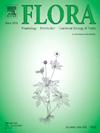Morphological and productivity responses of Guinea grass (Panicum maximum) under large trees in a South African savanna
IF 1.7
4区 生物学
Q3 ECOLOGY
引用次数: 0
Abstract
While herbaceous productivity typically decreases as woody plants become more abundant, there have also been reports of positive feedback, especially from single-standing larger woody species. The shade-tolerant and nitrophilous grass, Panicum maximum (Jacq) has been documented to colonise and flourish under tree canopies, especially large trees. However, information is lacking about the impact of large trees on P. maximum morphological and productivity responses under woody species with different functional traits (i.e. N-fixing ability) and canopy architectures. This study aimed to 1) evaluate the impact of large trees on morphological characteristics and biomass production of P. maximum, 2) determine the effect of deciduous vs non-deciduous trees on P. maximum morphological dynamics and production, and 3) to establish if functional qualities such as N-fixing ability modulate P. maximum responses under leguminous trees over two growing seasons (January 2022 and 2023). The study findings showed that P. maximum plants growing outside tree canopies had a significantly greater number of tillers and tuft sizes compared to the ones growing under tree canopies. No significant differences were found on P. maximum plant height among the microsites. However, P. maximum plant's vegetative height, leaf sizes and biomass production were enhanced under tree canopies. Additionally, the inflorescence length and the percentage of reproductive tillers of P. maximum plants recorded under Searsia lancea (evergreen tree) canopies were substantially reduced. The study findings demonstrated that structural changes created by the expansion and establishment of woody species do not only modify the micro-environment but can also influence the growth and development of both vegetative and reproductive parts of understory grasses.
求助全文
约1分钟内获得全文
求助全文
来源期刊

Flora
生物-植物科学
CiteScore
3.30
自引率
10.50%
发文量
130
审稿时长
54 days
期刊介绍:
FLORA publishes original contributions and review articles on plant structure (morphology and anatomy), plant distribution (incl. phylogeography) and plant functional ecology (ecophysiology, population ecology and population genetics, organismic interactions, community ecology, ecosystem ecology). Manuscripts (both original and review articles) on a single topic can be compiled in Special Issues, for which suggestions are welcome.
FLORA, the scientific botanical journal with the longest uninterrupted publication sequence (since 1818), considers manuscripts in the above areas which appeal a broad scientific and international readership. Manuscripts focused on floristics and vegetation science will only be considered if they exceed the pure descriptive approach and have relevance for interpreting plant morphology, distribution or ecology. Manuscripts whose content is restricted to purely systematic and nomenclature matters, to geobotanical aspects of only local interest, to pure applications in agri-, horti- or silviculture and pharmacology, and experimental studies dealing exclusively with investigations at the cellular and subcellular level will not be accepted. Manuscripts dealing with comparative and evolutionary aspects of morphology, anatomy and development are welcome.
 求助内容:
求助内容: 应助结果提醒方式:
应助结果提醒方式:


